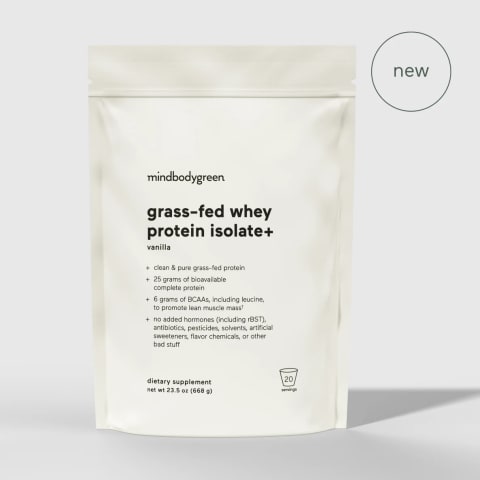Advertisement
I'm An RD & Here's How I Went From Eating 60 To 100 Grams Of Protein Daily


Last year, as I was interviewing experts for mindbodygreen's 2024 Well-Being Forecast (which predicted that the high-protein movement will challenge toxic diet culture), I got a brutal wake-up call. I definitely wasn't reaching my daily protein goals. Heck, I didn't even know what my protein intake goals should be—and I'm a dietitian.
I did some mental math as clinical nutritionist Kelly LeVeque revealed her recommendation to get 30-50 grams of protein in each of the first two meals of the day and realized I was falling way short.
LeVeque told me that following this high-protein protocol for 10-14 days is usually long enough to realize the benefits on body composition, blood sugar, and energy levels.
So that's what I set out to do: Complete two weeks of a high-protein diet. Here's how it went.
My starting point: Calculating my protein needs
My first step was to gauge what a high-protein diet looks like for me. During my dietetic training, I was taught that eating 0.8 gram per kilogram of body weight provides most healthy adults with enough protein. Turns out, this is the bare minimum amount of protein to avoid a nitrogen imbalance.
Now, research shows and many experts agree that the average, active adult needs significantly more protein than that—somewhere in the range of 1.6-2.2 grams per kilogram of body weight a day.
So, since my goal was to go high-protein, I narrowed my range to 1.8-2.2 g/kg to get 82-100 grams of protein a day.
Taking inventory of my current protein intake
The next step was to identify how much protein I was currently consuming. I downloaded a macronutrient tracker on my phone, and typed in some recipes and foods I eat frequently.
Overall, my current daily intake ranged from about 60 to 75 grams a day (not as bad as I thought), meaning I needed about 30-40 more grams of protein daily to consistently reach my goal. With the right strategy, I knew I could do it.
Devising a strategy
Typically, I plan my meals for the week around plants (grains leading the charge for breakfast and vegetables for lunch and dinner). Protein was always present, but it was frankly an afterthought.
For this experiment, I started planning my meals around protein—specifically animal proteins. And I planned to serve myself more than the 3-ounce portions I typically gravitate toward. For these two weeks, I aimed for 5-6 ounces of servings of meat or seafood during meals.
Breakfast was a bit harder to plan for until I decided to finally incorporate a whey protein powder. Whey protein isolate offers a concentrated source of high-quality bioavailable protein. But many brands I looked into filled their whey protein with artificial flavors, sugar alcohols, and dyes. So, I opted for mindbodygreen's (clean) grass-fed whey protein isolate+.
After all this planning, I was ready to jump into the high-protein life.
Breakfast
For breakfast, I tend to like something carby. So I leaned into a lot of Greek yogurt, nuts, seeds, and grass-fed whey protein isolate+. This was my first time trying a whey protein powder, and I loved how it added an extra 25 grams (!) of protein to whatever I was eating—mainly overnight oats and yogurt. This protein powder leaves out all the junk that litters so many other products, and the vanilla flavor is truly delicious.
Average protein: 35-40 grams
Lunch & snacks
For lunch, I tend to be pretty lazy. To hit my protein threshold, I loved tossing a can of salmon or tuna (34 grams of protein) into a big salad. Or I would do a midday breakfast variation with scrambled eggs and a fruit smoothie (featuring the whey protein of course).
If I needed a snack, I reached for a slice of whole grain toast and peanut butter or a bowl of cottage cheese and sliced bell peppers.
Average protein: 35 grams
Dinner
For dinner, I would whip up an easy chicken-thigh sheet-pan dish, shrimp tacos, a fish filet, or a tofu stir fry.
Average protein: 35-40 grams
What I learned
Turns out LeVeque was right. I felt so good during these two weeks. Protein has a strong satiating effect1, and I absolutely felt full and satisfied, not just between meals but for the entire day.
During my workouts—even my morning fasted ones—I felt stronger and more energized. And while I don't eat that much sugar, I never once craved a sweet treat. In fact, I'm not sure I had more than two or three mini peanut butter cups the entire two weeks.
And as someone who has always naturally leaned into intuitive eating practices, I was most hesitant about tracking what I ate. But once I got a good visual of the volume of protein I needed (which took me about three days), I dropped the tracking and let my intuition lead once again. It was a much-needed way to recalibrate my mind-body connection.
The challenges
While I did more easily meet (and sometimes surpass) my daily protein goal of 100 grams, I do think it came at the expense of some diversity in the plants I was consuming. Apparently I could only focus on one thing at a time.
As I continue down this high-protein track, my goal is to take a page from my fellow editor Hannah's playbook and shoot for eating 30+ plants a week.
And lastly, my grocery bill was a bit higher than normal from pretty much doubling the amount of animal protein I was eating.
Tips for eating more protein
If you're looking to level up your protein game, here are my top three recommendations:
- Look at the high-protein foods you're currently eating and just increase your serving size.
- Invest in a high-quality whey protein with at least 25 grams of protein for serving (it's just so convenient).
- Choose higher-protein carbs like bean or lentil pasta, teff, spelt, and amaranth.
The takeaway
Eating 100 grams of protein may sound like a crazy high goal, but with the proper planning, it'll become second nature in no time. I quickly realized that this was the eating pattern my body's been craving all along. LeVeque was right, I won't be looking back.
Watch Next
Enjoy some of our favorite clips from classes
Enjoy some of our favorite clips from classes
What Is Meditation?
Mindfulness/Spirituality | Light Watkins
Box Breathing
Mindfulness/Spirituality | Gwen Dittmar
What Breathwork Can Address
Mindfulness/Spirituality | Gwen Dittmar
The 8 Limbs of Yoga - What is Asana?
Yoga | Caley Alyssa
Two Standing Postures to Open Up Tight Hips
Yoga | Caley Alyssa
How Plants Can Optimize Athletic Performance
Nutrition | Rich Roll
What to Eat Before a Workout
Nutrition | Rich Roll
How Ayurveda Helps Us Navigate Modern Life
Nutrition | Sahara Rose
Messages About Love & Relationships
Love & Relationships | Esther Perel
Love Languages
Love & Relationships | Esther Perel
What Is Meditation?
Box Breathing
What Breathwork Can Address
The 8 Limbs of Yoga - What is Asana?
Two Standing Postures to Open Up Tight Hips
How Plants Can Optimize Athletic Performance
What to Eat Before a Workout
How Ayurveda Helps Us Navigate Modern Life
Messages About Love & Relationships
Love Languages
Advertisement

Yes, There's A Longevity Vitamin (& People Over 40 Need To Prioritize It)
Molly Knudsen, M.S., RDN

Study Investigates How Fasting Impacts Sleep, Hormone Health & More
Gretchen Lidicker, M.S.

Yes, There's A Longevity Vitamin (& People Over 40 Need To Prioritize It)
Molly Knudsen, M.S., RDN

Study Investigates How Fasting Impacts Sleep, Hormone Health & More
Gretchen Lidicker, M.S.

Yes, There's A Longevity Vitamin (& People Over 40 Need To Prioritize It)
Molly Knudsen, M.S., RDN

Study Investigates How Fasting Impacts Sleep, Hormone Health & More
Gretchen Lidicker, M.S.

Yes, There's A Longevity Vitamin (& People Over 40 Need To Prioritize It)
Molly Knudsen, M.S., RDN

Study Investigates How Fasting Impacts Sleep, Hormone Health & More
Gretchen Lidicker, M.S.















